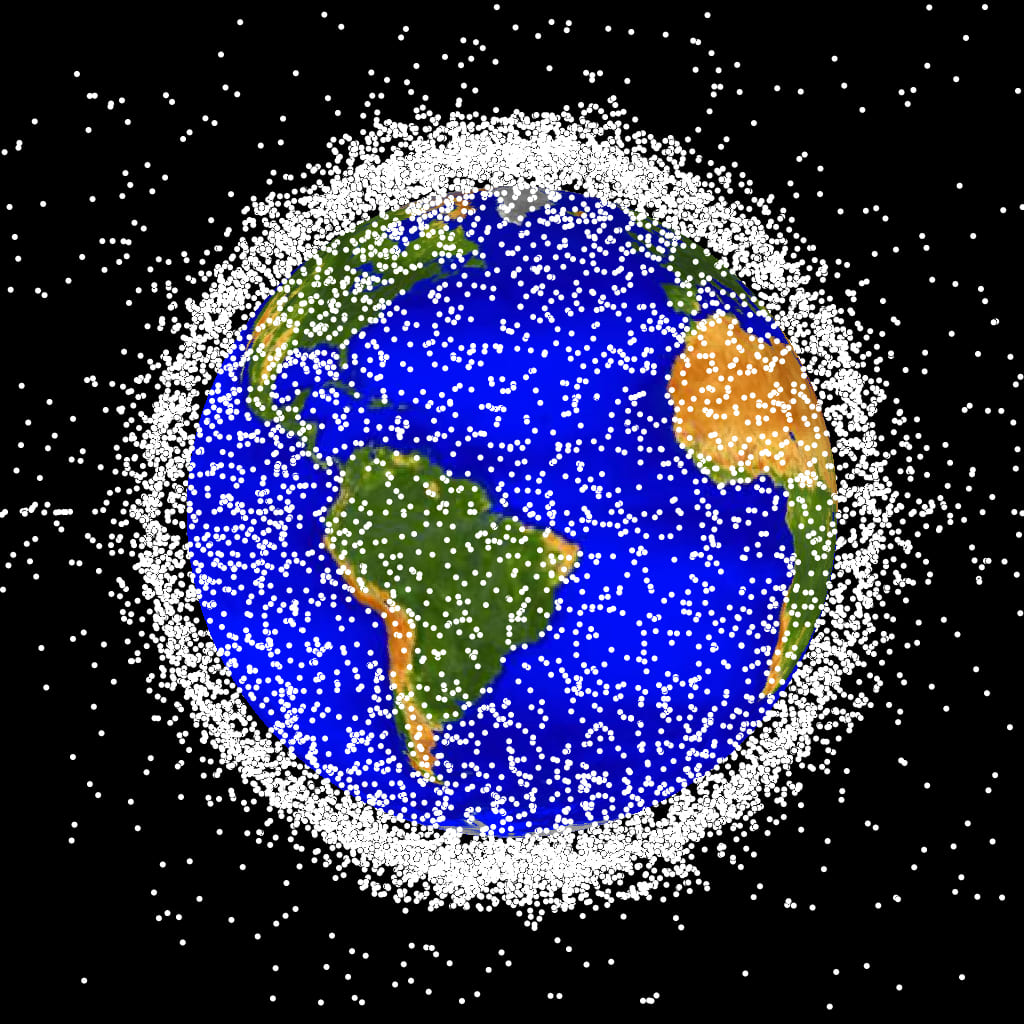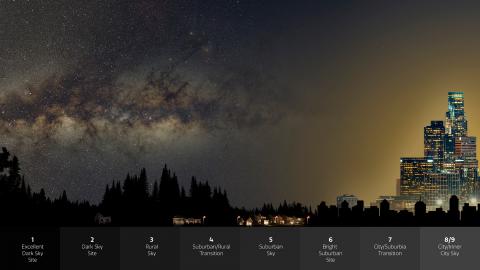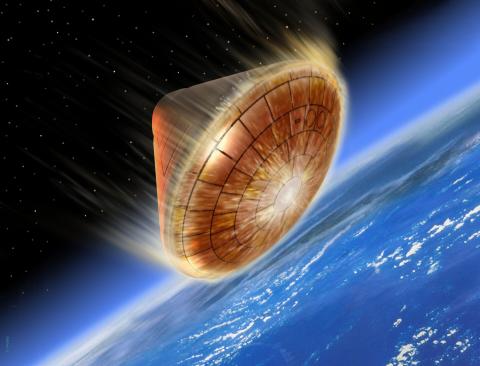Reactions: two articles denounce the impact of space debris and near-Earth satellites on the night sky
Space debris and satellites orbiting close to Earth have proliferated in recent years. Two articles in Nature Astronomy warn of their impact on light pollution. In the first, a team calculates the increase in the brightness of the night sky and warns of the effect on ecosystems and astronomical observations from Earth. In the second, which is a commentary, the authors call for limiting the production of artificial light and the number of satellites in orbit, calling on the scientific community to take on the big space and big light companies. Both articles are co-signed by Salvador Bará, from the Agrupación Astronómica Coruñesa, and the second by Fabio Falchi, from the University of Santiago de Compostela.

Recreation of Low-Earth Orbit, located less than 2,000 kilometres from the Earth's surface, where there is the highest concentration of orbital debris. Credit: NASA ODPO.
David Galadí - contaminación satélites EN
David Galadí-Enríquez
Lecturer in the Department of Physics at the University of Cordoba
These are two complementary, relevant and novel articles that propose a change in approach to the environmental effects of the proliferation of artificial satellites and artificial light at night. One paper is scientific in nature, while the other, published as a commentary, takes a view that focuses on cultural, political and economic considerations.
The scientific study 'Aggregate effects of proliferating low-Earth-orbit objects and implications for astronomical data lost in the noise' is signed by a group of specialists with a long experience in this type of work and the highest prestige in the international community dedicated to these matters. Their conclusions are solid within the margin allowed by the available information, and extend the conclusions of previous studies in a direction that has been little studied. In particular, but not only, they draw attention to the general increase in sky brightness caused by large populations of small orbiting objects.
The main uncertainties facing this analysis stem from two sources: from the lack of knowledge of the future evolution of projects to place mega-constellations of satellites in orbit, and from the fact that data on small pieces of space debris are not available to the general civilian population.
Even so, the conclusions are of the utmost relevance. The article makes a considerable scientific and argumentative advance towards including light pollution in the broader scope of environmental problems and insists that the earth's surface, atmosphere and near space must be treated as an integral and integrated continuum, worthy of protection when considered as a whole.
The commentary 'A call for scientist to halt the spoiling of the night sky with artificial light and satellites', although not of a scientific-technical nature, raises a series of political, social and economic reflections that will not leave the scientific community indifferent.
The most striking aspect is the proposal to shift the focus from mitigating impacts through collaboration with polluting companies (which are asked to self-regulate) to addressing the problem from the point of view of top-down regulation. They also publish a series of considerations on artificial light as a pollutant that move the debate from the industrial and engineering realm (where it used to be) to the centre of the field of environmental studies. Their central thesis is that artificial light at night, whether from lighting or satellites, should be treated as an air pollutant, and that ways to control it should be designed from that point of view, both in terms of scientific-technical criteria and in terms of organisational, political, business, economic and communication issues.
Olga Zamora - contaminación satélites EN
Olga Zamora
Support astronomer at the Canary Islands Institute of Astrophysics
Regarding the article: 'Aggregate effects of proliferating low-Earth-orbit objects and implications for astronomical data lost in the noise'.
"The article is of good quality and focuses on the effects of an increase in the sky background due to the proliferation of space debris and new satellite megaconstellations. Several points of view are taken into account: from the significant economic cost to observatories of having to increase exposure times to carry out their scientific programmes to the cultural loss of night darkness for humanity. The work takes into account existing evidence about the already polluted night sky, even in places with the best conditions for astronomical observations, to which should be added the uncontrolled launch of small satellites into low-Earth orbit. Although the work focuses on the optical range, the consequences for radio astronomical observation would be catastrophic".
Regarding the article: 'A call for scientists to halt the spoiling of the night sky with artificial light and satellites':
"The article seeks to raise awareness of the loss of the night sky and the pernicious effects of satellite megaconstellations. The best measure to prevent this is, without a doubt, to avoid the uncontrolled launch of these satellite constellations into low-Earth orbit. The international regulatory framework on the use of outer space needs to be changed, a task that does not seem easy despite the efforts that have already been made to do so. The loss is not only for astronomy but for humanity as a whole, so in addition to calling on scientists to mobilise, other actions must be deployed to gain public support."
Alejandro Sánchez - contaminación satélites EN
Alejandro Sánchez de Miguel
EMERGIA post-doctoral research in the Sky Quality Office
Regarding: 'Aggregate effects of proliferating low-Earth-orbit objects and implications for astronomical data lost in the noise': "In general, [this research] is a continuation of previous work and at the moment there is nothing to suggest that it is not correct.
"Overall, [this research] is a continuation of previous work and at the moment there is nothing to suggest that it is not correct. Independent evidence, such as the paper published a few months ago in the journal Science by [Christopher] Kyba, points in the same direction.
The most important limitation is the lack of specially designed experiments to measure sky brightness at observatories at this level of detail.
Regarding: 'A call for scientists to halt the spoiling of the night sky with artificial light and satellites'.
"In principle, and as recently discussed in a paper by the Spanish Association of Aeronautic and Space Law, both terrestrial and space light pollution fall within the scope of application of the [Convention] on Transboundary [Air] Pollution.
Therefore, it would be possible to hold accountable the countries that are launching the mega constellations that signed that treaty. That would only be efficient for nations like the US and the UK, but perhaps not for China [which has not signed the convention].
Regarding the limitations on the use of LEDs, from my point of view, the statement that either a limit is placed on emissions or light pollution will not be reduced is correct. In Spain, since 2007, there is an obligation for administrations to reduce light pollution, but this is totally ignored.
Another interesting aspect is that astronomers' attention is drawn to it. But in general, [many] professional astronomers (contrary to what the majority of the population may think) do not care about light pollution because it does not affect them, as much of the research is not done from the ground or in the visible range.
John C. Barentine et al.
- Research article
- Peer reviewed
- Modelling
Fabio Falchi et al.
- Comment
- Non-peer-reviewed



